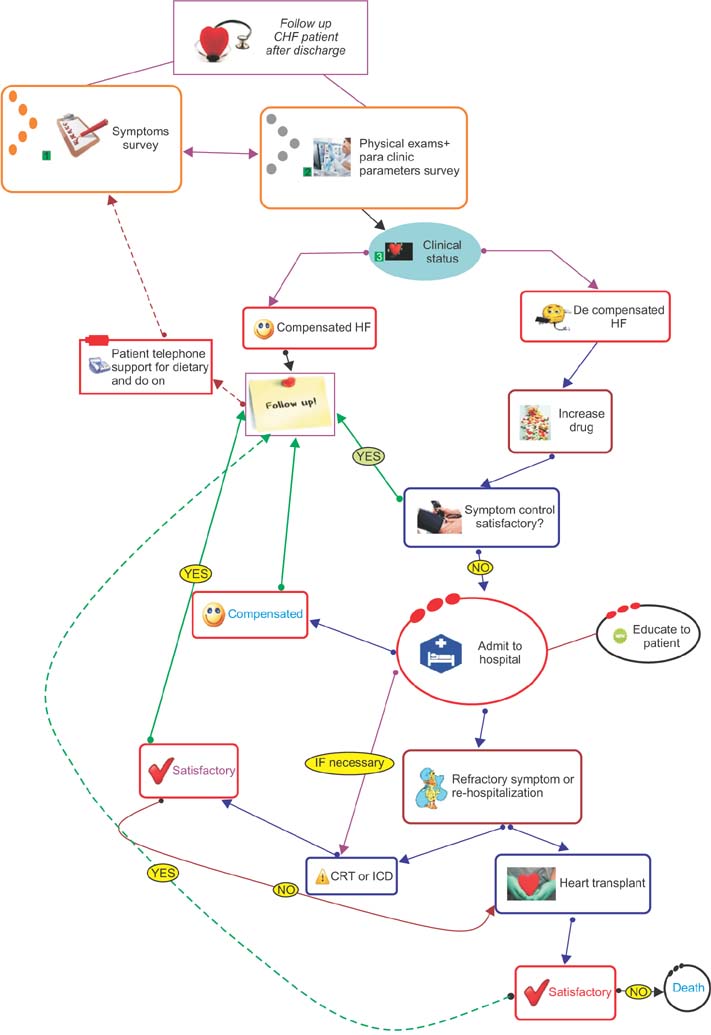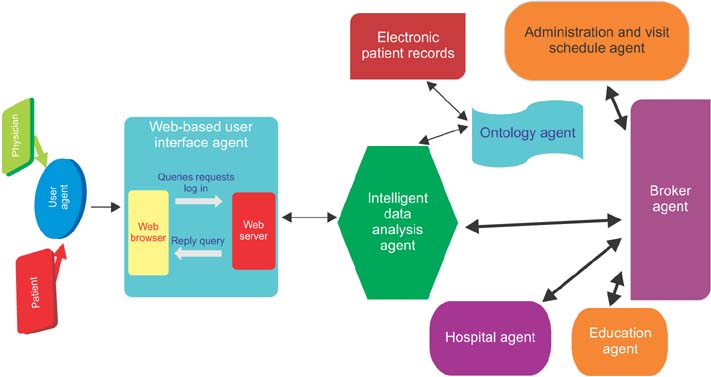Healthc Inform Res.
2015 Oct;21(4):307-314. 10.4258/hir.2015.21.4.307.
Chronic Heart Failure Follow-up Management Based on Agent Technology
- Affiliations
-
- 1Department of Health Information Management, Paramedical Faculty, Tehran University of Medical Sciences, Tehran, Iran. nmohammadzadeh@razi.tums.ac.ir
- KMID: 2166881
- DOI: http://doi.org/10.4258/hir.2015.21.4.307
Abstract
OBJECTIVES
Monitoring heart failure patients through continues assessment of sign and symptoms by information technology tools lead to large reduction in re-hospitalization. Agent technology is one of the strongest artificial intelligence areas; therefore, it can be expected to facilitate, accelerate, and improve health services especially in home care and telemedicine. The aim of this article is to provide an agent-based model for chronic heart failure (CHF) follow-up management.
METHODS
This research was performed in 2013-2014 to determine appropriate scenarios and the data required to monitor and follow-up CHF patients, and then an agent-based model was designed.
RESULTS
Agents in the proposed model perform the following tasks: medical data access, communication with other agents of the framework and intelligent data analysis, including medical data processing, reasoning, negotiation for decision-making, and learning capabilities.
CONCLUSIONS
The proposed multi-agent system has ability to learn and thus improve itself. Implementation of this model with more and various interval times at a broader level could achieve better results. The proposed multi-agent system is no substitute for cardiologists, but it could assist them in decision-making.
MeSH Terms
Figure
Reference
-
1. Ky B, French B, Levy WC, Sweitzer NK, Fang JC, Wu AH, et al. Multiple biomarkers for risk prediction in chronic heart failure. Circ Heart Fail. 2012; 5(2):183–190.
Article2. Heidenreich PA, Sahay A, Kapoor JR, Pham MX, Massie B. Divergent trends in survival and readmission following a hospitalization for heart failure in the Veterans Affairs health care system 2002 to 2006. J Am Coll Cardiol. 2010; 56(5):362–368.
Article3. Koehler F, Winkler S, Schieber M, Sechtem U, Stangl K, Bohm M, et al. Impact of remote telemedical management on mortality and hospitalizations in ambulatory patients with chronic heart failure: the telemedical interventional monitoring in heart failure study. Circulation. 2011; 123(17):1873–1880.
Article4. Mohammadzadeh N, Safdari R, Rahimi A. Multi-agent system as a new approach to effective chronic heart failure management: key considerations. Healthc Inform Res. 2013; 19(3):162–166.
Article5. Abraham WT, Adamson PB, Bourge RC, Aaron MF, Costanzo MR, Stevenson LW, et al. Wireless pulmonary artery haemodynamic monitoring in chronic heart failure: a randomised controlled trial. Lancet. 2011; 377(9766):658–666.
Article6. Dunin-Keplicz B, Verbrugge R. Teamwork in multiagent systems: a formal approach. Hoboken (NJ): John Wiley & Sons;2011.7. Villar A, Federici A, Annicchiarico R. Agents and healthcare: a glance to the future. In : Annicchiarico R, Cortes U, Urdiales C, editors. Agent technology and e-health. Basel, Switzerland: Birkhauser;2008. p. 141–148.8. Mala M. A multi-agent system based approach to emergency management. In : Proceedings of 2012 6th IEEE International Conference on Intelligent Systems; 2012 Sep 6-8; Sofia, Bulgaria. p. 95–101.9. Rodriguez S, Corchado JM, Fernandez A, Ossowski S, Julian V, Botti V. A THOMAS based multi-agent system for recommendations and guidance in malls. J Phys Agent. 2009; 3(2):21–26.
Article10. Protogeros N. Agent and web service technologies in virtual enterprises. Hershey (PA): Information Science Reference;2008.11. Lin H. Architectural design of multi-agent systems: technologies and techniques: technologies and techniques. Hershey (PA): Information Science Reference;2007.12. McMurray JJ, Adamopoulos S, Anker SD, Auricchio A, Bohm M, Dickstein K, et al. ESC Guidelines for the diagnosis and treatment of acute and chronic heart failure 2012: The Task Force for the Diagnosis and Treatment of Acute and Chronic Heart Failure 2012 of the European Society of Cardiology. Developed in collaboration with the Heart Failure Association (HFA) of the ESC. Eur Heart J. 2012; 33(14):1787–1847.13. Jessup M, Abraham WT, Casey DE, Feldman AM, Francis GS, Ganiats TG, et al. 2009 focused update: ACCF/AHA Guidelines for the diagnosis and management of heart failure in adults: a report of the American College of Cardiology Foundation/American Heart Association Task Force on Practice Guidelines: developed in collaboration with the International Society for Heart and Lung Transplantation. Circulation. 2009; 119(14):1977–2016.
Article14. Quick reference guide for health professionals: diagnosis and management of chronic heart failure [Internet]. Canberra, Australia: Heat Foundation;2011. cited at 2015 Sep 15. Available from: http://www.heartfoundation.org.au/SiteCollectionDocuments/Chronic-heart-failure-QRG-2011.pdf.
- Full Text Links
- Actions
-
Cited
- CITED
-
- Close
- Share
- Similar articles
-
- Multi-Agent System as a New Approach to Effective Chronic Heart Failure Management: Key Considerations
- Optimal Management of Chronic Medical Conditions Through Digital Medicine
- Acute Heart Failure and Its Management
- Optimal Management of Heart Failure with Preserve Ejection Fraction
- Role of cardiac imaging in management of heart failure



